Deborah J. Ross's Blog, page 133
March 17, 2014
Grief in Real Life and Fiction
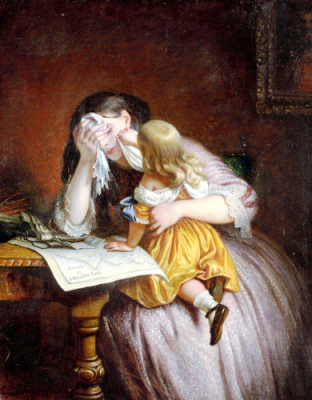 My best friend died last October, and I spent 7 weeks taking care of her and her family. I just finished a draft of a memorial for our college alumni magazine, to be reviewed by her husband, so I've been thinking about loss and grief. Because we haven't lived in the same state for -- oh, 40 years, I think -- I didn't see her on a daily basis. Our contacts were more along the lines of picking up the phone to chat or convey some noteworthy news or ask for support. So periods of time will go by in which I would not normally see or speak to her, and in these times, I'm not aware of sadness at her absence.
My best friend died last October, and I spent 7 weeks taking care of her and her family. I just finished a draft of a memorial for our college alumni magazine, to be reviewed by her husband, so I've been thinking about loss and grief. Because we haven't lived in the same state for -- oh, 40 years, I think -- I didn't see her on a daily basis. Our contacts were more along the lines of picking up the phone to chat or convey some noteworthy news or ask for support. So periods of time will go by in which I would not normally see or speak to her, and in these times, I'm not aware of sadness at her absence.For her husband, though, her death means a daily -- maybe hourly -- reminder that she is no longer there. He is surrounded by physical reminders, not to mention the rhythms of their daily lives. Our grief therefore has a different pattern.
The first deep grief of my life came in my late 20s, when my father died. It was after a series of strokes over the course of 6 months or so, following a period of declining health. Even so, I felt overwhelmed by the pain of his loss. In retrospect, I believe I wasn't fully adult, even though I was married and working full time. I could not imagine a life without my parents, their constant love and support, their kindness, their lively intellectual conversations. The intensity of my grief lessened, and then returned. After a while, I began to recognize the wave-like rhythm. I knew that the pain would subside and then rise up again - "This too shall pass." One of the most helpful things I did was to give myself time. I told myself it would take 5 years to do the majority of the grieving, and as it turns out, I was right.
Mourning my mother was far more complicated because of the suddenness and violence involved. She'd been in excellent health, and the murder/rape was exceptionally brutal. My sister and I had to deal with the criminal justice system -- the police investigation, the indictment and sentencing of the perpetrator, his subsequent parole hearings, etc. -- as well as the newspaper headlines and how shocked everyone around us was at the same time as attempting to negotiate the natural grieving process. Five years wasn't nearly enough to grapple with the emotional pain. But time and lots of therapy, seeking out healing, slowly loosened the knots, let sunshine into wounded places, and brought me to a place where it felt I would have been if my mother had died naturally.
Time is something we have (if we are fortunate, and even if we're not, we do better if we live our lives with patience and gentleness for ourselves). But fictional characters may not have it. Stories take place within a limited amount of time. Beginning writers have a tendency to truncate or skim over the grieving process. A character dies, everyone close to him is sad and sometimes angry, then they go on with their adventures, occasionally referencing his loss. Or maybe turning his death into an obsession. Neither depiction is emotionally healthy or honest. Both set examples of destructive, unrealistic grief.
Dead characters, like dead loved ones in real life, persist in the hearts and memories of the survivors. Sometimes these have more power and influence than the characters had when they were alive. This is one of the best reasons I've ever heard for killing off characters! Here are some thoughts on how to bring what happens in healthy grief into a fictional context.
Grief is complex. It's never simple sadness, and the closer the survivor was to the deceased, the more ambivalent and conflicting feelings she will have. Sadness, certainly, but also anger, guilt, even relief.
Grief is not linear in time. As I described above, it comes in cycles. It can be triggered by seemingly unrelated events, and the pain can be displaced to a current character or event. The survivor may not be aware of what's happening, but with skillful handling, the reader will be.
Grief shades future relationships. This is one of the most enduring and potentially disturbing aspects of loss -- perfect fodder for torturing your protagonist! When our old dog died last year, I wasn't even aware that I was looking for his replacement -- a dog just like him. Expectations are like premeditated resentments because they can never be truly satisfied. I had the good fortune to not do anything permanent before I realized what was going on. Once I'd given myself the time to grieve for the old dog properly, I became ready to embrace a new one as a personality in herself.
Grief comes back to haunt us at the most unexpected and inopportune times. Maybe that's because when we're not attending to our emotional healing, we carry around open wounds. Or that could just be psychbabble. But it makes for some great fictional material!
Grief can be peaceful and comforting. It's a natural process, and one almost all of us will experience. We humans have the capacity to appreciate what we have lost and to honor the depth of the love we shared with the departed. Even if the relationship is difficult or recent and undeveloped, we recognize the bond, the resonance within ourselves. In fiction, we can heighten the significance of even very brief relationships, then kill off one of the characters. (Think of the impact of Boromir's death on Aragorn in The Lord of the Rings.) Allowing ourselves to deeply experience the loss of a loved one helps us reconcile with our own mortality, and also gives us a sense of timelessness and oneness with all creation.
The painting is by Charles West Cope, The News From Sebastopol, 1875

Published on March 17, 2014 12:32
March 15, 2014
Gorgeous lace-weight yarn from Peace Fleece
 I'm an avid knitter, and one of my favorite places to buy yarn is Peace Fleece. They started during the Cold War as a way to bring together Russian and American sheepfarmers. Now they buy wool not only from Russia but Native American and Palestinian sources. Proceeds from their "Baghdad Blue" yarn help support "Neve Shalom," a Palestinian/Israeli village that is a workshop for friendship and cooperation.
I'm an avid knitter, and one of my favorite places to buy yarn is Peace Fleece. They started during the Cold War as a way to bring together Russian and American sheepfarmers. Now they buy wool not only from Russia but Native American and Palestinian sources. Proceeds from their "Baghdad Blue" yarn help support "Neve Shalom," a Palestinian/Israeli village that is a workshop for friendship and cooperation.Now they've partnered with a nonprofit to make available lace-weight mohair yarn that's just gorgeous.
Peace Fleece is working together with Adventure Yarns, a non-profit that assists Tajik women farmers in the production of quality Angora goat fiber and teaches spinners, knitters and weavers how to produce luxury mohair yarns for export. (Click through for more amazing pictures).
These mohair spinners have very few sources of income besides seasonal agricultural work picking fruit or cotton. Their main source of livelihood is money sent by men in the family who work in Russia. About 50% of Tajikistan's GDP comes from these funds - the highest % in the world. Spinning is their only stable source of income. Working part time they can spin 1 skein of yarn in 2 days. With the money they earn from spinning one skein of yarn they can buy: 1 kg of chicken, 1 liter of milk, 1 loaf of bread, 1 kg of potatoes.


Published on March 15, 2014 17:45
March 14, 2014
Negotiating With Cats
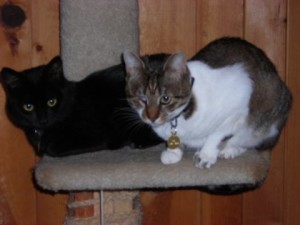 One of my favorite lines from Ghost Busters is a description of Armageddon, the End of Times – “dogs and cats, living together!” The stereotype is that that dogs and cats are fundamentally incompatible, born enemies. But dogs and cats can form communities – families – based on learned communication, play, and safety. To do this, especially with adult animals, requires a little help from their resident monkeys.
One of my favorite lines from Ghost Busters is a description of Armageddon, the End of Times – “dogs and cats, living together!” The stereotype is that that dogs and cats are fundamentally incompatible, born enemies. But dogs and cats can form communities – families – based on learned communication, play, and safety. To do this, especially with adult animals, requires a little help from their resident monkeys.Tajji, our “new-to-us” retired seeing eye dog, lived most of her adult life in a household without cats. We assumed that at some point in her early socialization, before her intensive seeing eye training, she was exposed to them. When she came for a preliminary visit, we locked the cats behind closed bedroom doors. She was very excited when off-leash, checking out the house. We gave her a chance to calm down, then put up a baby gate so that we could open the bedroom doors, the cats could come out, and the animals could see and smell one another without undue risk to the cats. Tajji was very interested in checking them out, up close and personal. Shakir hid, but Gayatri came out and sat in the living room, being very polite with her back turned to the dog.
A word about our cats. They’re both rescue adoptees, so we don’t know their early history with dogs, but clearly each of them had had some exposure. The important thing for cats to learn is not to run, because a small critter moving swiftly away will engage the dog’s prey drive. Shakir (black male) was exceptionally friendly with our old dog, relentlessly pursing play behavior even when the dog was clearly not up for close contact with any creature that had razor blades on its feet. Gayatri (brown tabby and white, one eyed female) was more outgoing with our puppy, Darcy. So each of them had had the experience of living with a dog. Cats who are confident with dogs will teach the dogs how to behave, especially if their resident monkeys are careful to set things up so everyone stays calm and safe during the introductory period.
To facilitate safe introductions, we used barriers and escape places. We placed baby gates across strategic doorways (and a big one to divide the living room from dining/kitchen areas). We made sure that every room had high places for the cats to escape to. We transitioned from hello-across-gates, where the cats could determine their comfort distance, to placing the dog in her crate and then letting the cats loose in the same room. This involves a “foundational” skill for the dog – happily going into her crate on command. High-value (super extra tasty) treats and chew toys are useful!
After a few days, we saw the cats acting in a more relaxed manner and the dog moving more slowly. Dogs want to move quickly toward something small and furry and interesting-smelling. Rapid movement like that, especially in a straight line, is threatening to both species, as is direct eye contact. This is a good place to talk about interspecies communication.
Both cats and dogs use body language to communicate. Some things mean the same to both species, but some things don’t, leading to either the opposite message being understood or simple confusion.
Here are a few things cats and dogs share:
Direct eye contact is menacing. Dilated pupils mean you are stressed and likely to react with fear aggression.Moving quickly toward you in a straight line is threatening. Moving slowly and on a curved path sends a calming signal.Looking away is polite, as is turning the entire body at an angle.Soft eyes (blinking or relaxing the muscles around the eyes) mean friendly intentions.Nose-touch is a greeting, implying a certain degree of trust has already been established.Here are some behaviors that are typically misunderstood:
Tail wagging/lashing.“Play bow” means nothing to cats. Nor does a lip-lick, a sign of stress.“Puppy ears” and “puppy licking” (below the mouth) are submissive gestures in dogs that have no equivalents in cats, as far as I know.Cats and dogs can learn to live amicably with one another, even as adults, but they need time to adjust in small steps. For some, particularly those without prior experience, a week of sniffing through closed doors, with rotation through other spaces in the house, might be required. We expected to use barriers for a couple of weeks. As it turned out, once the flurry of a new animal in a new place had died down, both species started exhibiting signs of willingness to come closer.
Gayatri was the first to make overtures. She communicated her friendly intentions (from the other side of the baby gate) by moving slowly at right angles to Tajji, not looking directly at Tajji, and finally lowering herself to the ground, facing away. Within 10 days, Tajji was learning to move slowly around the cats and to look away. By that time, Shakir had emerged from his hiding place; in several on-the-floor encounters, Shakir let Tajji know that he wasn’t afraid of her and by gum, she was going to back off or he’d come after her, swatting and hissing (which he did on at least one occasion). Both cats have swatted at the dog, usually with sheathed claws – warning, not attack.
About 2 weeks into our pet-integration, the baby gates are gone, although the dog crate remains for other reasons. Shakir has begun initiating physical contact with Tajji, not only touching noses but rubbing against her muzzle and front legs. She holds very still. She knows who is boss.
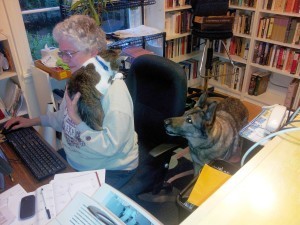 This scene is from fairly early in the introduction process. Gayatri is in one of her favorite places, my shoulder, and she and Tajji are checking each other out. They are curious, but neither is relaxed. Gayatri's tension shows in the tuck of her head, and Tajji's around her mouth and eyes. Contrast this to the following encounter with Shakir:
This scene is from fairly early in the introduction process. Gayatri is in one of her favorite places, my shoulder, and she and Tajji are checking each other out. They are curious, but neither is relaxed. Gayatri's tension shows in the tuck of her head, and Tajji's around her mouth and eyes. Contrast this to the following encounter with Shakir: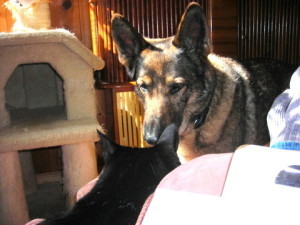 Tajji approaches Shakir. Her eyes are soft and her head slightly lowered.
Tajji approaches Shakir. Her eyes are soft and her head slightly lowered. 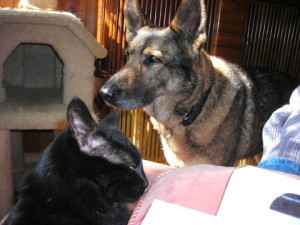 The next moment, both animals execute a beautiful "Look Away" to indicate their friendly intentions. Compare Tajji's relaxed mouth to the image with Gayatri. Shakir has half-closed his eyes in an additional gesture of non-threatening intentions.
The next moment, both animals execute a beautiful "Look Away" to indicate their friendly intentions. Compare Tajji's relaxed mouth to the image with Gayatri. Shakir has half-closed his eyes in an additional gesture of non-threatening intentions.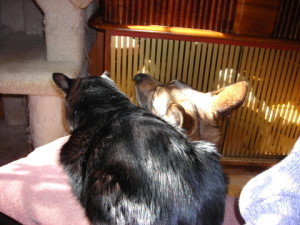 Tajji lies down so that she and Shakir are now facing the same direction. Her body is at a slight angle to Shakir's. Their heads are within a foot of one another, and both have "happy" sideways ears. They are well on their way to becoming best buddies.
Tajji lies down so that she and Shakir are now facing the same direction. Her body is at a slight angle to Shakir's. Their heads are within a foot of one another, and both have "happy" sideways ears. They are well on their way to becoming best buddies.If you want to learn more about reading dog body language, two excellent sources to begin with are:
Rugaas, Turid. On Talking Terms With Dogs: Calming Signals.
Aloff, Brenda. Canine Body Language: A Photographic Guide. Interpreting the Native Language of the Domestic Dog.

Published on March 14, 2014 01:00
March 13, 2014
GUEST POST: Maya Kaathryn Bohnhoff on Reviewing Bad Books
It's a joy to review books I've enjoyed, even when they have flaws. Sometimes the flaws not only don't spoil my reading pleasure, but they add charm. But what about books I thought were just awful? Or so crippled by flaws -- diction, plot holes, character idiocies, anachronisms, flabby pacing, you name it -- that I just wanted to grab the author by the lapels and scream, Learn the basics! As satisfying as that might be, is it a good idea? Why or why not? When and when not?
Here's what Maya Kaathryn Bohnhoff has to say:
Maya Kaathryn Bohnhoff is the New York Times Bestselling author of Star Wars: The Last Jedi and Star Wars: Shadow Games. Maya became addicted to science fiction when her dad let her stay up late to watch The Day the Earth Stood Still. Mom was horrified. Dad was unrepentant. Maya slept with a night-light in her room until she was 15. She started her writing career sketching science fiction comic books in the last row of her third grade classroom. She was never apprehended. Since then her short fiction has been published in Analog, Amazing Stories, Century, Realms of Fantasy, Interzone, Paradox and Jim Baen’s Universe. Her debut novel, The Meri (Baen), was a Locus Magazine 1992 Best First Novel nominee (now available as a trade paperback from Sense of Wonder Press ). Since, she has published ten more speculative fiction novels, including collaborations with Marc Scott Zicree and Michael Reaves.
Check out her work on Book View Cafe.
Here's what Maya Kaathryn Bohnhoff has to say:
I comment negatively on authors who are “big” enough to take it. Dan Brown isn’t going to be crushed by my frustration with the way he dumbs down his characters in key places or tries to milk a reveal by repeating it several times as if you’ve never heard it before. Nor is it going to put a wrinkle in his sales. But I hesitate to be as blunt with writers who are just getting their sea legs. What I might do is praise what I find praiseworthy first, give a sort of “on the other hand” commentary about the things I found bothered me, then end on a note of general uplift. For example, “if you aren’t bothered by X, the book might win you over.”
In all cases I think it’s better to say as precisely as possible what you do and don’t like and why so that the person reading the critique or hearing it, can decide for themselves whether the elements that drove me nuts even matter to them. I found Rick Riordan’s “Lightning Thief” so flawed that I was reluctant to keep buying the series for my daughter, though I found the characters very engaging. It had plot holes you could sail a galleas through (oars and all) yet other readers (many of them writers) were so caught up in the story those didn’t register.
So for me, that’s the key: try to critique in such a way that your own biases or sensibilities are also revealed instead of saying, “I didn’t like it” or the dreaded “It didn’t work for me.”
Maya Kaathryn Bohnhoff is the New York Times Bestselling author of Star Wars: The Last Jedi and Star Wars: Shadow Games. Maya became addicted to science fiction when her dad let her stay up late to watch The Day the Earth Stood Still. Mom was horrified. Dad was unrepentant. Maya slept with a night-light in her room until she was 15. She started her writing career sketching science fiction comic books in the last row of her third grade classroom. She was never apprehended. Since then her short fiction has been published in Analog, Amazing Stories, Century, Realms of Fantasy, Interzone, Paradox and Jim Baen’s Universe. Her debut novel, The Meri (Baen), was a Locus Magazine 1992 Best First Novel nominee (now available as a trade paperback from Sense of Wonder Press ). Since, she has published ten more speculative fiction novels, including collaborations with Marc Scott Zicree and Michael Reaves.
Check out her work on Book View Cafe.

Published on March 13, 2014 01:00
March 11, 2014
Characters Hurling Insults For Fun and Profit
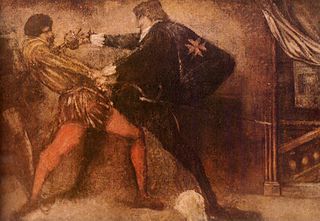 How many times has a discussion escalated into an argument, or an argument into violence, with the hurling of insults? It seems we human beings never outgrow the impulse to call people who disagree with us nasty names. There have been enough compilations of creative, gleeful, or historical insults to fill entire libraries. We so much enjoy our own cleverness that we blithely ignore whether calling someone names actually encourages them to change their behavior or whether it firmly cements their own negative opinion of us and their determination to not do whatever it is we want. The words we use and the comparisons we make say as much about us as about those we are insulting. The same is true for characters in fiction.
How many times has a discussion escalated into an argument, or an argument into violence, with the hurling of insults? It seems we human beings never outgrow the impulse to call people who disagree with us nasty names. There have been enough compilations of creative, gleeful, or historical insults to fill entire libraries. We so much enjoy our own cleverness that we blithely ignore whether calling someone names actually encourages them to change their behavior or whether it firmly cements their own negative opinion of us and their determination to not do whatever it is we want. The words we use and the comparisons we make say as much about us as about those we are insulting. The same is true for characters in fiction.Let’s accept as given that the purpose of insults is not reconciliation. If that were true, we’d have long since achieved peace in the Middle East, not to mention a few dozen other places around the globe. What are the other possibilities?
Venting ill temper, including displaced aggression – that’s the man who kicks his dog instead of his boss, the real target of his anger.Showing off for a third party. Parroting what has been said by those the character respects.Being out of control. If violence is the last refuge of the incompetent, then surely hurling insults is an expression of frustration in a person who simply can’t come up with a constructive response.Trying to provoke a reaction, whether it’s loss of control in the other character or an escalation of violence.Justifying previous ill-treatment of the person being insulted.
Some of these motives are deliberate, calculated to evoke a specific response, but others are just the opposite. Assuming a character knows what he’s doing and does it on purpose, how invested is he in the result? He might get what he wants, but he might not. One of those two overgrown schoolboys taunting one another might turn the other cheek. Or might laugh in his face. What does your character do then?
The parallel to this is how a character reacts when she realizes she’s crossed a line, that she’s out of control, and that to large extent depends upon how self-aware she is. Some people are so embarrassed, they escalate hostilities, trying to get the other person’s response to justify their own lapse in judgment. Others will back off if given the opportunity, for instance if a third party steps in and lowers the tension. A character could realize what he’s done, lack the skills to remedy the situation, participate in whatever bad things happen next, and carry away a secret feeling of guilt for the outcome.
Then there’s the particularly (and often deliciously) odious character who is in perfect control of himself and hurls insults deliberately. The cruelty has a purpose, and if the character is challenged on his own behavior, he justifies it as being in the best interests of the person being insulted. “For your own good,” “to toughen you up,” that sort of thing.
Sometimes insults are a form of betrayal. Is this deliberate or unconscious? Heated words inflicted on a friend or loved one in the moment, without reflection on the hurt they cause? Even if the hurt is verbally forgiven, do the effects of a moment of ill-considered pique change the relationship? And how might the resulting resentment and guilt play out over time?
Now to flip the mirror and look at the character being insulted, who really is the person with the power in this situation. She has the greatest degree of freedom in her actions, whether to respond in kind or in some other way; whether to walk away, whether to draw out the suspense of the encounter; whether to end the exchange for good or let it fester – or encourage that festering. What is his history in the relationship and will he use the insult to settle an old score or will he refuse to take it personally – and why?
Therein lies a tale or twenty…

Published on March 11, 2014 01:00
March 10, 2014
World-Building in Prose and Theatrical Set Design
Last year at Baycon, Juliette Wade and I did a discussion and reading on "World-building." One of the members of our audience, a theatrical set designer, offers some great insights into the similarities...and the lessons we can learn from one another.
Read the whole blog post here:
World Building | setsandlights
PS The selection I read was from Collaborators, my Lambda Award-Finalist novel that takes place on a planet whose indigenous race is gender-fluid.
The biggest lesson I learned from Ross was to present the world incidentally through the action of the story. I don’t want to imply that Ross was Worldbuilding by accident, far from it. Instead she introduced readers to the complex concepts of an alien world as she was dealing with other writerly stuff such as plot and character. While Wade’s reading demonstrated rich narrative passages that allowed the reader to see the world, Ross’s reading jumped straight in to the action, but carefully crafted that action and her telling of it to expose the world we were visiting. Ross’s approach is also one that relates organically to the theatrical designer. Theatrical designers do not get to give the audience a two minute guided tour of the design so that they can take in what it is and what it means. Instead, the curtain goes up, the actors enter, and the play is off and running. The audience has to pick up the world of the play while following the action. Is this the sort of play where a Styrofoam cup and some string symbolizes a phone? If so, designers show that to the audience. Whatever the world of the play is, it is important to show it through the action of the play.
Read the whole blog post here:
World Building | setsandlights
PS The selection I read was from Collaborators, my Lambda Award-Finalist novel that takes place on a planet whose indigenous race is gender-fluid.

Published on March 10, 2014 01:00
March 9, 2014
Today's Thought on Writing
Close the door. Write with no one looking over your shoulder. Don't try to figure out what other people want to hear from you; figure out what you have to say. It's the one and only thing you have to offer. --Barbara Kingsolver

Published on March 09, 2014 18:59
March 6, 2014
COLLABORATORS is Lambda Awards Finalist!
 My science fiction novel, Collaborators, is a Finalist for the 2014 Lambda Literary Award! (It's under byline of Deborah Wheeler.) Needless to say, I'm thrilled! It was previously reviewed on the Lambda Literary site.
My science fiction novel, Collaborators, is a Finalist for the 2014 Lambda Literary Award! (It's under byline of Deborah Wheeler.) Needless to say, I'm thrilled! It was previously reviewed on the Lambda Literary site.ve stories between the alien pairs were the most important, and the most tender moments of the book, Not only for the fascinating look at sexual biology and the way Wheeler has shaken and blended gender norms like a Bond martini, but because they are also beautiful romances, familiar family issues, and heart-touchingly domestic. The aliens’ whole way of life is built on the family structure, the treasuring of the all-too-rare children, and the valuing of honesty and generosity between clan kin. The relationships span all ranges and makeups – from widowers to young lovers; from established partnerships with adult children to newlyweds with a baby on the way; from unrequited loves to loves cut tragically short. In this way, Wheeler has given us aliens with hearts as human as the readers, and that’s the point.
A starkly entertaining allegory of Middle East tensions, and a romantic and intellectually sexy gender discussion wrapped up in a compelling novel that solidifies Dragon Moon Press’ swiftly growing place amid the new wave of socially-aware and unafraid-to-make-its-readers-think genre fiction publishers.
- See more at: http://www.lambdaliterary.org/reviews... love stories between the alien pairs were the most important, and the most tender moments of the book, Not only for the fascinating look at sexual biology and the way Wheeler has shaken and blended gender norms like a Bond martini, but because they are also beautiful romances, familiar family issues, and heart-touchingly domestic. The aliens’ whole way of life is built on the family structure, the treasuring of the all-too-rare children, and the valuing of honesty and generosity between clan kin. The relationships span all ranges and makeups – from widowers to young lovers; from established partnerships with adult children to newlyweds with a baby on the way; from unrequited loves to loves cut tragically short. In this way, Wheeler has given us aliens with hearts as human as the readers, and that’s the point.
A starkly entertaining allegory of Middle East tensions, and a romantic and intellectually sexy gender discussion wrapped up in a compelling novel that solidifies Dragon Moon Press’ swiftly growing place amid the new wave of socially-aware and unafraid-to-make-its-readers-think genre fiction publishers.
- See more at: http://www.lambdaliterary.org/reviews... love stories between the alien pairs were the most important, and the most tender moments of the book, Not only for the fascinating look at sexual biology and the way Wheeler has shaken and blended gender norms like a Bond martini, but because they are also beautiful romances, familiar family issues, and heart-touchingly domestic. The aliens’ whole way of life is built on the family structure, the treasuring of the all-too-rare children, and the valuing of honesty and generosity between clan kin. The relationships span all ranges and makeups – from widowers to young lovers; from established partnerships with adult children to newlyweds with a baby on the way; from unrequited loves to loves cut tragically short. In this way, Wheeler has given us aliens with hearts as human as the readers, and that’s the point.
A starkly entertaining allegory of Middle East tensions, and a romantic and intellectually sexy gender discussion wrapped up in a compelling novel that solidifies Dragon Moon Press’ swiftly growing place amid the new wave of socially-aware and unafraid-to-make-its-readers-think genre fiction publishers.
- See more at: http://www.lambdaliterary.org/reviews... love stories between the alien pairs were the most important, and the most tender moments of the book, Not only for the fascinating look at sexual biology and the way Wheeler has shaken and blended gender norms like a Bond martini, but because they are also beautiful romances, familiar family issues, and heart-touchingly domestic. The aliens’ whole way of life is built on the family structure, the treasuring of the all-too-rare children, and the valuing of honesty and generosity between clan kin. The relationships span all ranges and makeups – from widowers to young lovers; from established partnerships with adult children to newlyweds with a baby on the way; from unrequited loves to loves cut tragically short. In this way, Wheeler has given us aliens with hearts as human as the readers, and that’s the point.
A starkly entertaining allegory of Middle East tensions, and a romantic and intellectually sexy gender discussion wrapped up in a compelling novel that solidifies Dragon Moon Press’ swiftly growing place amid the new wave of socially-aware and unafraid-to-make-its-readers-think genre fiction publishers.
- See more at: http://www.lambdaliterary.org/reviews... love stories between the alien pairs were the most important, and the most tender moments of the book, Not only for the fascinating look at sexual biology and the way Wheeler has shaken and blended gender norms like a Bond martini, but because they are also beautiful romances, familiar family issues, and heart-touchingly domestic. The aliens’ whole way of life is built on the family structure, the treasuring of the all-too-rare children, and the valuing of honesty and generosity between clan kin. The relationships span all ranges and makeups – from widowers to young lovers; from established partnerships with adult children to newlyweds with a baby on the way; from unrequited loves to loves cut tragically short. In this way, Wheeler has given us aliens with hearts as human as the readers, and that’s the point.
A starkly entertaining allegory of Middle East tensions, and a romantic and intellectually sexy gender discussion wrapped up in a compelling novel that solidifies Dragon Moon Press’ swiftly growing place amid the new wave of socially-aware and unafraid-to-make-its-readers-think genre fiction publishers.
- See more at: http://www.lambdaliterary.org/reviews... love stories between the alien pairs were the most important, and the most tender moments of the book, Not only for the fascinating look at sexual biology and the way Wheeler has shaken and blended gender norms like a Bond martini, but because they are also beautiful romances, familiar family issues, and heart-touchingly domestic. The aliens’ whole way of life is built on the family structure, the treasuring of the all-too-rare children, and the valuing of honesty and generosity between clan kin. The relationships span all ranges and makeups – from widowers to young lovers; from established partnerships with adult children to newlyweds with a baby on the way; from unrequited loves to loves cut tragically short. In this way, Wheeler has given us aliens with hearts as human as the readers, and that’s the point.
A starkly entertaining allegory of Middle East tensions, and a romantic and intellectually sexy gender discussion wrapped up in a compelling novel that solidifies Dragon Moon Press’ swiftly growing place amid the new wave of socially-aware and unafraid-to-make-its-readers-think genre fiction publishers.
- See more at: http://www.lambdaliterary.org/reviews... read sections from this book at Gaylaxicon 2004 in San Diego, and more recently at SF in SF. Special thanks to everyone who kept asking when the book was coming out and to Gabrielle Harbowy, my editor at Dragon Moon Press, for believing in it!
From the Lambda Literary review: The love stories between the alien pairs were the most important, and the most tender moments of the book, Not only for the fascinating look at sexual biology and the way Wheeler has shaken and blended gender norms like a Bond martini, but because they are also beautiful romances, familiar family issues, and heart-touchingly domestic. The aliens’ whole way of life is built on the family structure, the treasuring of the all-too-rare children, and the valuing of honesty and generosity between clan kin. The relationships span all ranges and makeups – from widowers to young lovers; from established partnerships with adult children to newlyweds with a baby on the way; from unrequited loves to loves cut tragically short. In this way, Wheeler has given us aliens with hearts as human as the readers, and that’s the point.
A starkly entertaining allegory of Middle East tensions, and a romantic and intellectually sexy gender discussion wrapped up in a compelling novel that solidifies Dragon Moon Press’ swiftly growing place amid the new wave of socially-aware and unafraid-to-make-its-readers-think genre fiction publishers.- See more at: http://www.lambdaliterary.org/reviews/06/18/collaborators-by-deborah-wheeler/#sthash.lAYqCGiL.dpuf
To read more about gender and gender roles in Collaborators, check out my previous blogs: Collaborators - Thinking About Gender and World-Building in Collaborators – Designing a Gender-Fluid Race
Collaborators is available in print and ebook editions from Amazon.com and in print from Powell's and probably from other places, too.

Published on March 06, 2014 11:49
March 5, 2014
The Seven-Petaled Shield - in Elvish!
While there are no elves, Tolkienesque or otherwise, in The Seven-Petaled Shield trilogy, there seems to be a huge overlap in reading readers. Someone joked that if The Lord of the Rings had been written by a woman, it would be these books. Kate Hoffman, my editor at DAW, wrote out the titles of the three books, transcribed into Tolkien's Elvish:

It is indeed a marvelous thing to discover that one's editor is as great a Tolkien fangirl as oneself.
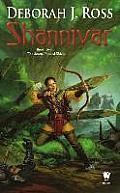


It is indeed a marvelous thing to discover that one's editor is as great a Tolkien fangirl as oneself.


Published on March 05, 2014 16:12
February 28, 2014
Welcoming an Old Dog
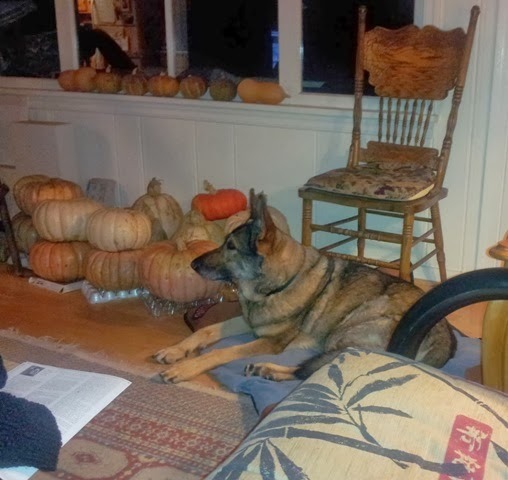 Tajji guarding pumpkinsMy husband, fellow writer Dave Trowbridge, and I have languished in the condition known as Dog Withdrawal. Our wonderful old German Shepherd Dog, Oka, died last April from leukemia at the august age of 12 ½ (GSDs typically live 9-12 years), and the lively puppy who bounced into our lives later that spring went to find a new home (on a ranch owned by rodeo ropers) when I was out of the state for almost two months, caring for a dying friend. After that, we decided to give ourselves time to properly grieve both losses, an act of faith that the universe would present us with the right dog at the right time.
Tajji guarding pumpkinsMy husband, fellow writer Dave Trowbridge, and I have languished in the condition known as Dog Withdrawal. Our wonderful old German Shepherd Dog, Oka, died last April from leukemia at the august age of 12 ½ (GSDs typically live 9-12 years), and the lively puppy who bounced into our lives later that spring went to find a new home (on a ranch owned by rodeo ropers) when I was out of the state for almost two months, caring for a dying friend. After that, we decided to give ourselves time to properly grieve both losses, an act of faith that the universe would present us with the right dog at the right time.The way this works is you have to give the universe a helping hand from time to time. So both of us spoke of the “German Shepherd Dog-sized hole” in our lives. As it happened, a musician (French horn) in two of the bands Dave plays in (bass and soprano clarinet) is married to a blind man whose seeing eye dog was nearing retirement age. Seeing eye work is strenuous for dogs, both physically and mentally. It requires constant alertness, lightning reflexes, and the strength and speed to instantly pull an owner out of harm’s way. After some discussion, they brought their dog over for a visit. We got to meet Tajji (which means “my crown” in Arabic, her owner being Egyptian), a lovely, sweet-tempered German Shepherd Dog. She’s 10 years old and in good shape for her age with beautiful, strong conformation. Coincidentally, she is a sable (sometimes called “gray” or “Grau”) like Oka. In fact, except for the difference in their sizes, she looks like a feminine version of him.
I think service dogs must have an on/off switch, at least, this particular seeing eye dog does. She’s intensely focused on her work while in harness, but when it comes off, it’s as if she entered a time warp to when she was a young dog at the beginning of her socialization. So we had a lot of running around, investigating everything (cats safely behind closed doors!), jumping on people and furniture, but all with a kind of softness. Even a gentle “no” or “leave it” had instant positive results.
 Oka herding ballWe noticed right away how different Tajji’s temperament is from that of our previous dogs. Oka, like many GSDs, was quite aloof with strangers. That’s a breed characteristic. And Darcy, our puppy, had the combination of puppy energy and high-end competitive dog intensity. But Tajji, once she was off-harness, greeted us sweetly and enthusiastically and then would return from her exploration of the house to ask me and Dave for attention. She also has a much lower prey drive than Oka did. Both make sense when you think about what’s needed in a service animal who will be raised in one family, trained by someone else, and finally assigned to a new person, and be expected to bond with each of these. (And it would not be a good thing at all for a service dog to take off after small fleeing things like squirrels!) Not only that, but she has stayed with friends and dog sitters many times over the years while her owner traveled abroad to places he didn’t feel were safe for his dog. These prior experiences made it more likely that Tajji would be able to integrate well into a new family despite her age.
Oka herding ballWe noticed right away how different Tajji’s temperament is from that of our previous dogs. Oka, like many GSDs, was quite aloof with strangers. That’s a breed characteristic. And Darcy, our puppy, had the combination of puppy energy and high-end competitive dog intensity. But Tajji, once she was off-harness, greeted us sweetly and enthusiastically and then would return from her exploration of the house to ask me and Dave for attention. She also has a much lower prey drive than Oka did. Both make sense when you think about what’s needed in a service animal who will be raised in one family, trained by someone else, and finally assigned to a new person, and be expected to bond with each of these. (And it would not be a good thing at all for a service dog to take off after small fleeing things like squirrels!) Not only that, but she has stayed with friends and dog sitters many times over the years while her owner traveled abroad to places he didn’t feel were safe for his dog. These prior experiences made it more likely that Tajji would be able to integrate well into a new family despite her age.We were so clearly the perfect new home that Tajji’s owner decided to make the transfer permanent now rather than follow the preliminary plan, which was to have her stay with us while he traveled, then return to him until he received a replacement dog. It became clear to everyone that a single change, emotionally wrenching as it is, would be much better for both dog and owner.
We prepared the house by setting up the largest of our dog crates adjacent to the dining area and placing baby gates in strategic doorways as see-through, smell-through cat barriers, bringing in additional dog beds so there is one in every major room, digging out our collection of dog toys, and supplying ourselves with yummy liver dog treats (tiny ones for small dogs, so as to give a burst of deliciousness without requiring chewing and without adding a ton of extra food intake). We discussed the situation with the cats, but I don’t think they took our warnings seriously.
Last Sunday, Tajji moved in, complete with her old familiar bed and a T shirt that her owner had worn and not washed, so it smells like him. I played with her in our large fenced yard and then we took her for a walk. Our semi-rural neighborhood is full of wonderful things to smell – all the local dogs, cats, squirrels, deer, raccoons, skunks…. We are determined to convince her this is dog heaven, where liver treats rain from the sky and every day is packed with play!
Needless to say, we have fallen in love with her already!

Published on February 28, 2014 01:00



